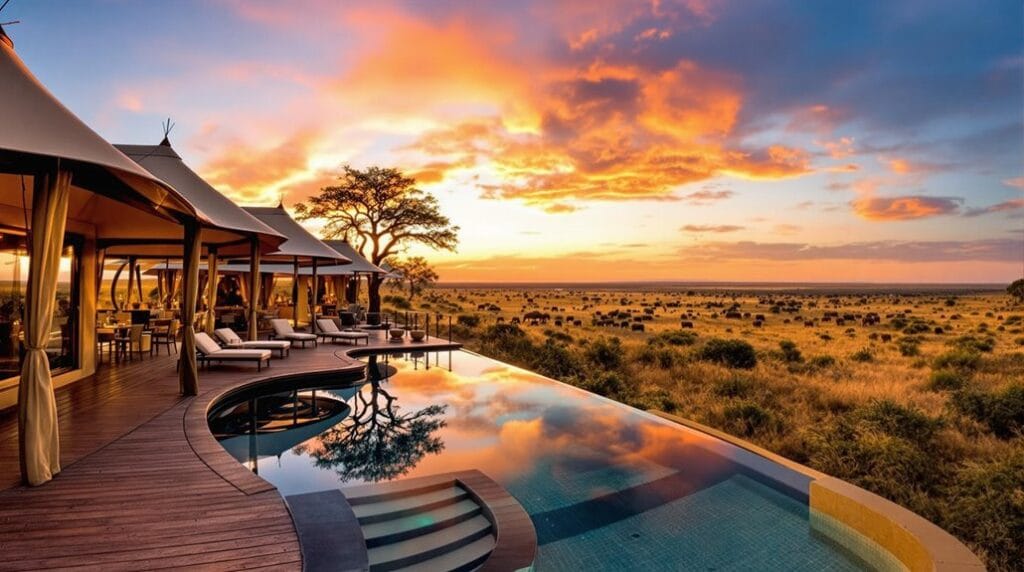Africa's cultural heritage sites are a mosaic of history and artistry, each piece telling a story that shapes the continent's identity. You might find yourself drawn to the Rock-Hewn Churches of Lalibela, where faith and craftsmanship intertwine, or perhaps to the solemn grounds of Robben Island, echoing with tales of resilience. As you explore these treasures, you'll uncover the layers of civilization that have thrived here. But which sites truly capture the essence of Africa's diverse heritage? The answer might surprise you.
Key Takeaways
- Rock-Hewn Churches of Lalibela: Explore 12th-century monolithic churches in Ethiopia, symbolizing a New Jerusalem for Ethiopian Christians and showcasing remarkable architectural ingenuity.
- Robben Island: Visit the historical site where Nelson Mandela was imprisoned, offering insights into South Africa's struggle against apartheid and resilience for freedom.
- Great Zimbabwe National Monument: Discover the impressive stone ruins of the Shona civilization, reflecting their socio-political structure and cultural identity from 1100-1450 AD.
- Victoria Falls: Witness one of the world's largest waterfalls on the Zambezi River, marveling at its natural beauty and the power of cascading water.
- Osun-Osogbo Sacred Grove: Experience Yoruba culture in Nigeria through this sacred grove, featuring sculptures and shrines, and participate in the vibrant annual Osun-Osogbo Festival.
Rock-Hewn Churches of Lalibela
Nestled in the highlands of Ethiopia, the Rock-Hewn Churches of Lalibela stand as a tribute to the country's rich religious and architectural heritage. This UNESCO World Heritage Site comprises 11 monolithic rock-cut churches, with the Church of St. George being the most iconic, skillfully carved from striking red volcanic rock.
Constructed during the reign of King Lalibela in the 12th century, these churches were designed to symbolize a New Jerusalem for Ethiopian Christians, reflecting the deep spiritual significance they hold.
The architectural techniques employed here are nothing short of remarkable. Carved directly from the rock, these structures showcase a unique blend of ingenuity and artistry, underlining Ethiopia's historical prowess in both culture and architecture.
Especially, Lalibela is surrounded by nearly 200 additional churches, amplifying its importance as a pilgrimage center for Christians worldwide.
The site epitomizes Ethiopia's rich religious heritage and stands as a symbol of the country's ability to blend cultural and natural elements into its architectural landscape.
Visiting Lalibela offers a profound understanding of its historical significance and the enduring spirit of Ethiopian Christianity, making it an essential stop for any cultural heritage enthusiast.
Robben Island
Robben Island stands as a powerful symbol of South Africa's tumultuous history, particularly during the apartheid era.
As you explore its grounds, you'll encounter the very cells where Nelson Mandela endured nearly two decades of imprisonment, a stark reminder of the personal sacrifices made in the fight for freedom.
The island not only symbolizes political oppression but also plays an essential role in cultural heritage and preservation, inviting reflection on resilience and social justice.
Historical Significance of Robben Island
The historical significance of Robben Island lies in its transformation from a place of isolation to a powerful symbol of resistance against apartheid in South Africa. This UNESCO World Heritage Site served as a political prison for Nelson Mandela, where he spent 18 of his 27 years incarcerated. The harsh conditions faced by inmates, including forced labor and limited contact with the outside world, underscore the human rights abuses prevalent during this era.
Originally, Robben Island functioned as a leprosy and mental illness hospital and even served as a military base during World War II. However, it's the legacy of political oppression that resonates most strongly today. The island stands as a monument to the resilience and determination of those who fought against racial injustice.
Now, as a museum and educational site, Robben Island offers tours that enlighten visitors about its critical role in South Africa's struggle for freedom. By visiting, you not only gain insight into Mandela's fight but also engage with the broader context of a nation's quest for equality, making Robben Island a must-visit for anyone interested in the profound lessons of history.
Nelson Mandela's Imprisonment Experience
While enduring the oppressive conditions of Robben Island, Nelson Mandela's imprisonment became a defining chapter of his life and a pivotal moment in South Africa's history. For 18 of his 27 years behind bars, Mandela faced the harsh realities of a small, austere cell measuring just 2.4m by 2.1m.
This facility, originally built for leprosy patients, was repurposed during the apartheid era to confine political prisoners, making it a site of immense struggle and resilience.
Mandela endured forced labor and harsh treatment, yet his spirit remained unbroken. His time on Robben Island became a symbol of resistance against apartheid, highlighting the broader fight for freedom and justice in South Africa.
Designated a UNESCO World Heritage Site in 1999, Robben Island now stands as a poignant reminder of the sacrifices made in the quest for equality.
Today, visiting Robben Island offers you an opportunity to reflect on this significant chapter of history. Guided tours lead you through the prison, providing insights into the struggles faced by Mandela and his fellow inmates, and the enduring legacy of their fight against oppression.
Cultural Heritage and Preservation
Cultural heritage sites like Robben Island play an essential role in preserving collective memory and fostering understanding of historical injustices. As a UNESCO World Heritage Site, Robben Island stands as a powerful symbol of the struggle against apartheid in South Africa. Its history as a political prison, where Nelson Mandela endured 18 of his 27 years of incarceration, underscores the significance of this location in the narrative of freedom and resilience.
The island's past as a leprosy and mental illness hospital adds layers to its heritage, symbolizing the complex social issues faced by South Africans. Preservation efforts are critical in maintaining the historical buildings and artifacts that tell the stories of those who suffered for their beliefs.
Guided tours provide invaluable educational experiences, helping visitors grasp the broader context of the anti-apartheid movement. Designated a National Monument in 1996 and recognized by UNESCO in 1999, Robben Island's preservation is essential not only for South Africa but for the global community.
Great Zimbabwe National Monument
Nestled in the heart of Zimbabwe, Great Zimbabwe National Monument stands as a monumental tribute to the ingenuity and architectural prowess of the Shona civilization between 1100 and 1450 AD. As a UNESCO World Heritage Site, it offers a fascinating glimpse into the rich tapestry of African history and advanced construction techniques employed by ancient builders.
You'll be captivated by the impressive stone ruins, particularly the conical tower, which likely served as a granary. This structure exemplifies the sophisticated methods used by the Shona, who built without mortar, relying instead on interlocking stones to create enduring edifices.
Walking through the site, you can appreciate how these ancient builders reflected the socio-political structure of their civilization, with the ruins serving not only as homes but also as symbols of power and cultural identity.
Great Zimbabwe's architecture tells a story of resilience and innovation, showcasing the remarkable skills of a people who thrived in Southern Africa.
As you explore, you'll gain a deeper understanding of the region's heritage and the profound impact of the Shona civilization on the history of Africa.
Victoria Falls
Victoria Falls, often hailed as one of the world's most stunning natural wonders, captivates visitors with its breathtaking expanse and powerful cascades. Situated on the Zambezi River between Zambia and Zimbabwe, it's a UNESCO World Heritage Site that draws countless tourists each year.
To truly appreciate Victoria Falls, consider these striking features:
- Width: The falls span over 1.7 kilometers (1 mile), creating a spectacular vantage point for photography and sightseeing.
- Height: Plunging approximately 108 meters (354 feet) into the gorge below, the sheer drop is awe-inspiring and reinforces the power of nature.
- Water Flow: During peak flow, around 500 million liters of water cascade over the falls every minute, generating a mist that can be seen from up to 20 kilometers (12 miles) away.
First seen by Europeans in 1855, Dr. David Livingstone named it after Queen Victoria, embedding this natural wonder in both history and adventure.
Whether you're bungee jumping, white-water rafting, or simply soaking in the view, Victoria Falls promises an unforgettable experience that connects you with the raw beauty of the earth.
Ancient Thebes
Ancient Thebes, often regarded as the glorious heart of the New Kingdom, stands as a tribute to the grandeur of ancient Egyptian civilization. Located in modern-day Luxor, this UNESCO World Heritage Site reveals the monumental achievements of a society that thrived over three millennia ago.
The Temple of Amun-Re, part of the expansive Karnak complex, showcases classical Egyptian architecture, symbolizing both religious devotion and the city's political power.
As you explore Ancient Thebes, you'll find that it's not just a collection of ruins; it's a living representation of an era defined by its monumental temples and colossal statues.
The Valley of the Kings, situated nearby, enhances the city's significance as a royal burial ground, housing the tombs of notable pharaohs, including the famed Tutankhamun.
The meticulous craftsmanship and artistic expressions found in this region provide a deeper understanding of ancient Egyptian culture and history.
Each site within Ancient Thebes offers insights into the spiritual and political life of its people, making it an essential destination for anyone intrigued by the complexities of ancient civilizations.
Embrace the opportunity to connect with a remarkable chapter of human history.
Leptis Magna
Leptis Magna captivates visitors with its stunning remnants of Roman civilization, inviting you to explore a city that flourished along the North African coast. As one of the largest and most well-preserved Roman sites, it offers an outstanding universal perspective on ancient urban life.
Recognized as a UNESCO World Heritage Site, Leptis Magna combines history with breathtaking architecture.
As you wander through the ruins, you'll encounter:
- The magnificent amphitheater, constructed around 56 CE, where the echoes of ancient performances still linger.
- The sprawling forum, a vibrant center of trade and social interaction, showcasing the city's importance in the Roman Empire.
- The intricate temples, each telling stories of devotion and cultural significance, reflecting the diverse influences that shaped Leptis Magna.
Buried under sand for centuries, these structures escaped erosion and destruction, preserving their grandeur for future generations.
Exploring Leptis Magna not only immerses you in history but also provides insight into the architectural prowess of the Romans. Its exceptional features and historical importance make it an unmissable destination for anyone passionate about cultural heritage.
Old Towns of Djenné
When you explore the Old Towns of Djenné, the architectural significance of the Great Mosque immediately captures your attention with its stunning mudbrick design.
This remarkable structure not only showcases the ingenuity of local craftsmanship but also reflects the town's vibrant cultural celebrations, particularly the annual Crepissage de la Grand Mosquee.
Through these festivities, the community demonstrates its dedication to preserving their unique heritage, making Djenné a pivotal site in the cultural landscape of West Africa.
Architectural Significance
The Old Towns of Djenné captivates with its remarkable mudbrick architecture, a tribute to centuries of skilled craftsmanship and cultural blending. Recognized as a UNESCO World Heritage Site, Djenné's structures reflect the ingenuity of local builders who tailored their techniques to the hot Sahelian climate.
As you explore, you'll notice:
- The Great Mosque: The largest mud-brick building in the world, this magnificent structure was built in the 13th century and remains a focal point of the town.
- Urban Layout: The town's design showcases narrow streets and shaded alleys, facilitating airflow and comfort in the arid environment.
- Cultural Blend: Djenné's architecture represents a fusion of African and Islamic elements, illustrating its rich history as a trading hub during the trans-Saharan trade.
Every corner of the Old Towns of Djenné tells a story, merging aesthetic appeal with practical function.
The annual Crepissage de la Grand Mosquee festival highlights the community's ongoing commitment to preserving this architectural legacy, ensuring that the mudbrick masterpieces endure for generations to come.
Cultural Celebrations and Festivals
Amid the vibrant streets of Djenné, cultural celebrations come alive, particularly during the annual "Crepissage de la Grand Mosquée" festival. This event, held every June, marks the onset of the rainy season and the community's commitment to preserving their iconic mudbrick mosque, a UNESCO World Heritage Site. The festival involves locals coming together to replaster the Great Mosque, ensuring its structural integrity for the year ahead.
During these community celebrations, you'll witness traditional music, dance, and storytelling that vividly illustrate the rich cultural heritage of Djenné. The atmosphere buzzes with enthusiasm as families and friends engage in creating a tapestry of shared history and resilience.
This annual festival not only serves as a practical necessity but also deepens social bonds and cultural identity among the participants. Visitors and researchers flock to Djenné during this time, drawn by the unique mud architecture and the vibrant cultural practices that define the region.
The Great Mosque stands as a symbol of both spiritual significance and communal strength, reminding all of the intertwined nature of culture and architecture in Djenné.
Kilimanjaro National Park
As you explore Kilimanjaro National Park, you'll encounter not only Africa's highest peak but also a stunning array of ecosystems that thrive in this unique environment.
Designated a UNESCO World Heritage Site in 1987, this park is a treasure trove of biodiversity, featuring:
- Rainforest: Lush and vibrant, home to countless bird species and unique plants.
- Moorland: A rugged landscape dotted with giant heather and diverse wildlife, including elusive leopards.
- Alpine Desert: A stark, beautiful region where climbers push their limits to reach the summit of Mount Kilimanjaro.
Every year, approximately 25,000 hikers attempt to conquer Mount Kilimanjaro, with about two-thirds succeeding in this formidable challenge.
Yet, the park faces significant threats from climate change, particularly the alarming reduction of its glaciers.
As you traverse the trails, you'll not only witness breathtaking views but also play a part in the ongoing dialogue about ecological preservation.
Kilimanjaro National Park is essential for protecting critical wildlife habitats, ensuring that future generations can appreciate its extraordinary landscapes and diverse species.
Osun-Osogbo Sacred Grove
Nestled within the heart of Nigeria, the Osun-Osogbo Sacred Grove stands as a vibrant representation of the rich cultural tapestry of the Yoruba people. Recognized as a UNESCO World Heritage Site, this sacred grove was founded approximately 400 years ago and celebrates the spiritual significance of the Osun goddess in Yoruba religion.
As you explore the grove, you'll encounter over 20th-century sculptures and shrines, which reflect traditional African artistic expressions and the deep heritage of the Osogbo people. The grove spans about 75 hectares and hosts a diverse ecosystem, making it a critical site for both cultural and environmental conservation.
Every year, the Osun-Osogbo Festival attracts thousands who come to honor the goddess and seek her blessings for fertility and prosperity. This event not only highlights the cultural vibrancy of the community but also underscores the importance of preserving indigenous spirituality and traditional practices.
Visiting the Osun-Osogbo Sacred Grove offers you a unique opportunity to connect with a living tradition, where art, spirituality, and nature intertwine, creating a profound cultural experience.
Le Morne Cultural Landscape
As you explore the Le Morne Cultural Landscape, you'll encounter a profound historical narrative intertwined with breathtaking natural beauty.
This UNESCO World Heritage Site not only symbolizes the resilience of runaway slaves but also showcases the rich biodiversity of Mauritius.
The striking Le Morne Brabant mountain stands as a tribute to the cultural legacy and the vibrant fusion of influences that define this unique landscape.
Historical Significance and Legacy
Among the verdant landscapes of Mauritius, the Le Morne Cultural Landscape stands out not only for its breathtaking beauty but also for its profound historical significance. Designated a UNESCO World Heritage Site in 2008, this area embodies critical historical narratives surrounding slavery and resistance.
Consider these key elements that contribute to its rich legacy:
- Le Morne Brabant: This iconic mountain served as a refuge for escaped slaves, symbolizing their relentless struggle for freedom and human rights.
- Cultural Fusion: The site reflects the cultural heritage of both African and South Asian descent, showcasing the diverse histories that interweave within Mauritius.
- Annual Celebrations: Tributes to the legacy of the maroons enliven the landscape, ensuring that the stories of resilience and resistance are passed down through generations.
Together, these aspects create a powerful reminder of the human spirit's quest for liberty.
Natural Beauty and Biodiversity
The Le Morne Cultural Landscape captivates with its stunning natural beauty and rich biodiversity, inviting you to explore a unique interplay of ecosystems. Designated as a UNESCO World Heritage Site in 2008, this area not only showcases the iconic Le Morne Brabant mountain but also serves as a poignant symbol of the struggle for freedom among escaped slaves.
As you wander through the landscape, you'll encounter a variety of ecosystems, including coastal slopes, mangroves, and coral reefs. These environments contribute considerably to the region's biodiversity, housing several endemic species of flora and fauna. This makes Le Morne an essential site for conservation efforts, where protecting these unique life forms is critical.
Moreover, the natural beauty of Le Morne intertwines with its cultural heritage, reflecting a rich tapestry of history shaped by the fusion of African and South Asian influences. Each element of this landscape tells a story of resistance and resilience, inviting you to appreciate not just the scenic views, but also the profound narratives that lie beneath.
Engaging with the Le Morne Cultural Landscape enriches your understanding of both nature and culture in a singular, breathtaking setting.
Frequently Asked Questions
Which Country Has the Most World Heritage Sites in Africa?
If you're curious about which country boasts the most World Heritage Sites in Africa, you'll find South Africa leading with ten remarkable locations.
Each site reflects immense cultural significance, showcasing the country's diverse heritage.
Effective conservation efforts and meticulous site management are vital in preserving these treasures for future generations.
What Are Four South African Heritage Sites?
When exploring South Africa's heritage, consider Robben Island for its cultural significance as a symbol of resistance and historical preservation.
The Cradle of Humankind offers insight into local traditions and the evolution of humanity.
iSimangaliso Wetland Park showcases rich biodiversity, reflecting ecological heritage.
What Is the Most Visited World Heritage Site?
The most visited World Heritage site is the Great Pyramids of Giza. Their cultural significance lies in showcasing ancient Egyptian engineering and religious practices.
Millions flock to these pyramids annually, highlighting their immense tourism impact. As you explore the site, you'll appreciate not just the architectural marvels but also the rich history that shaped civilization.
The Pyramids' status as a UNESCO site further enhances their global recognition and importance in heritage conservation.
Why Was Liverpool Delisted From UNESCO?
Have you ever wondered how a city's history can be overshadowed by modern development?
Liverpool was delisted from UNESCO due to significant alterations that compromised its cultural significance.
The committee found that large-scale projects, like the Liverpool Waters development, violated UNESCO's criteria by disrupting the site's historical context.
This decision highlights the delicate balance between progress and preservation, reminding us that maintaining authenticity is essential for a site's lasting value in our global heritage.
Conclusion
Visiting Africa's cultural heritage sites isn't just a journey; it's a profound connection to the heart and soul of humanity. Each location whispers stories of resilience, artistry, and spirituality, inviting you to reflect on the threads that bind us all. Imagine standing before the ancient ruins or vibrant landscapes, feeling the echoes of history resonate within you. These experiences not only enrich your understanding but also ignite a passion for preserving the rich tapestry of our shared heritage.








